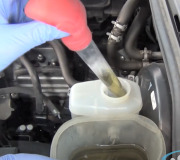Chris,
Here is a video and guide below to help you bleed the brake system correctly.
https://youtu.be/w7gUsj2us0U
and
https://www.2carpros.com/articles/how-to-bleed-or-flush-a-car-brake-system
and
https://youtu.be/WDxvEQrMkBg
Please run down these guides and report back.
If air was introduced into the ABS module (near the master cylinder) the ABS automated bleed needs performed. It requires a scan tool. Now, I am suggesting this since the master cylinder was replaced. Anytime air can get into the upper module, this needs done. Replacement of the master cylinder may have caused air to get in.
Vehicle Brakes and Traction Control Hydraulic System Brake Bleeding Service and Repair Procedures ABS Automated Bleed Procedure
ABS AUTOMATED BLEED PROCEDURE
ABS Automated Bleed Procedure
Important: In most circumstances a base brake bleed is all that is required for most component replacements (such as wheel cylinders, calipers, brake tubes, and master cylinder) except for BPMV replacement.
Caution: Refer to Brake Fluid Irritant Caution in Service Precautions.
Notice: Refer to Brake Fluid Effects on Paint and Electrical Components Notice in Service Precautions.
The following automated ABS bleed procedure is required when one of the following occur:
Manual bleeding at the wheel cylinders does not achieve the desired pedal height or feel.
Brake Pressure Modulator Valve replacement (BPMV).
Extreme loss of brake fluid has occurred.
Air ingestion is suspected.
If none of the above conditions apply use standard bleed procedures.
The auto bleed procedure is used on BOSH 5.3 equipped vehicles. This procedure uses a scan tool to cycle the system solenoid valves and run the pump in order to purge the air from the secondary circuits. These secondary circuits are normally closed off, and are only opened during system initialization at vehicle start up and during ABS operation. The automated bleed procedure opens these secondary circuits and allows any air trapped inside the BPMV to flow out toward the wheel cylinders or calipers where it can be purged out of the system.
Automated Bleed Procedure
Preliminary Inspection
1. Inspect the battery for full charge, repair the battery and charging system as necessary. Refer to Diagnostic System Check - Engine Electrical.
2. Connect a scan tool to the Data Link Connector (DLC) and select current and history DTCs. Repair any DTCs prior to performing the ABS bleed procedure.
3. Inspect for visual damage and leaks and repair as needed.
Preliminary Setup
1. Raise and vehicle on a suitable support.
2. Turn the ignition switch to OFF position.
3. Remove all four tires, if necessary refer to Tire and Wheel Removal and Installation.
4. Connect the pressure bleeding tool according to the manufacturer's instructions.
5. Turn the ignition switch to RUN position, engine off.
6. Connect a scan tool and establish communications with the ABS system.
7. Pressurize the bleeding tool to 206 to 241 kPa (30 to 35 psi).
Performing the Automated Bleed Procedure
1. Notice: The Auto Bleed Procedure may be terminated at any time during the process by pressing the EXIT button. No further Scan Tool prompts pertaining to the Auto Bleed procedure will be given. After exiting the bleed procedure, relieve bleed pressure and disconnect bleed equipment per manufacturers instructions. Failure to properly relieve pressure may result in spilled brake fluid causing damage to components and painted surfaces.
With the pressure bleeding tool at 206 to 241 kPa (30 to 35 psi), and all bleeder screws in closed position, select Automated Bleed Procedure on the scan tool and follow the instructions.
2. The first part of the automated bleed procedure will cycle the pump and front release valves for one minute. After the cycling has stopped the scan tool will enter a "cool down" mode and display a 3 minute timer. The auto bleed will not continue until this timer expired, and cannot be overridden.
3. During the next step, the scan tool will request the technician to open one of the bleeder screws. The scan tool will then cycle the respective release valve and pump motor for 1 minute.
4. The scan tool will repeat step 3 for the remaining bleeder screws.
5. With the bleeder tool still attached to the vehicle and maintaining 241 kPa (35 psi), the scan tool will instruct the technician to independently open each bleeder screw for approximately 20 seconds. This should allow any remaining air to be purged from the brake lines.
6. When the automated bleed procedure is completed the scan tool will display the appropriate message.
7. Install all four tires, if necessary refer to Tire and Wheel Removal and Installation.
8. Remove pressure from the pressure bleeding tool and then disconnect the tool from the vehicle.
9. Depress the brake pedal to gage pedal height and feel. Repeat steps 1 through 8 until the pedal is acceptable.
10. Remove the scan tool from the DLC connector.
11. Install.
12. Lower the vehicle.
13. Inspect the brake fluid level in master cylinder.
14. Road test the vehicle while making sure the brake pedal remains high and firm.
If vehicle is equipped with TCS the scan tool will cycle both the ABS and TCS solenoids valves. This bleed procedure is the same as above.
____________________________________________
Let me know if this helps or if you have other questions.
Take care,
Joe
Thursday, February 27th, 2020 AT 7:37 PM



